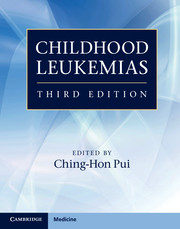Book contents
- Frontmatter
- Contents
- List of contributors
- Preface
- Section 1 History and general issues
- Section 2 Cell biology and pathobiology
- Section 3 Evaluation and treatment
- 12 Pharmacokinetic, pharmacodynamic, and pharmacogenetic considerations
- 13 Acute lymphoblastic leukemia
- 14 Relapsed acute lymphoblastic leukemia
- 15 B-cell acute lymphoblastic leukemia and Burkitt lymphoma
- 16 Acute myeloid leukemia
- 17 Relapsed acute myeloid leukemia
- 18 Myelodysplastic syndrome
- 19 Chronic myeloproliferative disorders
- 20 Leukemias in patients with Down syndrome
- 21 Treatment of adolescents and young adults with acute lymphoblastic leukemia
- 22 Hematopoietic stem cell and natural killer cell transplantation
- 23 Treatment of acute leukemia in countries with limited resources
- 24 Antibody-targeted therapy
- 25 Adoptive cellular immunotherapy
- 26 Gene transfer: methods and applications
- 27 Development therapeutics
- 28 Minimal residual disease
- Section 4 Complications and supportive care
- Index
- Plate Section
- References
23 - Treatment of acute leukemia in countries with limited resources
from Section 3 - Evaluation and treatment
Published online by Cambridge University Press: 05 April 2013
- Frontmatter
- Contents
- List of contributors
- Preface
- Section 1 History and general issues
- Section 2 Cell biology and pathobiology
- Section 3 Evaluation and treatment
- 12 Pharmacokinetic, pharmacodynamic, and pharmacogenetic considerations
- 13 Acute lymphoblastic leukemia
- 14 Relapsed acute lymphoblastic leukemia
- 15 B-cell acute lymphoblastic leukemia and Burkitt lymphoma
- 16 Acute myeloid leukemia
- 17 Relapsed acute myeloid leukemia
- 18 Myelodysplastic syndrome
- 19 Chronic myeloproliferative disorders
- 20 Leukemias in patients with Down syndrome
- 21 Treatment of adolescents and young adults with acute lymphoblastic leukemia
- 22 Hematopoietic stem cell and natural killer cell transplantation
- 23 Treatment of acute leukemia in countries with limited resources
- 24 Antibody-targeted therapy
- 25 Adoptive cellular immunotherapy
- 26 Gene transfer: methods and applications
- 27 Development therapeutics
- 28 Minimal residual disease
- Section 4 Complications and supportive care
- Index
- Plate Section
- References
Summary
Introduction
Pediatric leukemias and lymphomas, the most common childhood cancers, result from interactions between host and environment. The incidence rates of these disorders vary widely across geographic regions and ethnic, socioeconomic, and cultural groups. There is a wealth of biologic and epidemiologic data on pediatric cancers in North America and Europe, but comparable information is not available for most low- and mid-income countries, which lack hospital- or population-based registries and adequate diagnostic methods; for that reason, only marked regional discrepancies in cancer incidence are evident (Fig. 23.1). For example, non-Hodgkin lymphoma of the mature B-cell immunophenotype (Burkitt lymphoma [BL]) is the most common malignancy in children in many African countries. Although specific genetic factors may play a role, environmental factors, including infectious agents such as Epstein–Barr virus (EBV), human immunodeficiency virus (HIV), and malaria (highly prevalent in these regions), are believed to contribute to the etiology and high incidence of this disease in sub-Saharan countries. Other examples include an increased incidence of pediatric Kaposi sarcoma in regions with a high rate of endemic HIV infection, acute promyelocytic leukemia in children of Italian or Hispanic heritage, acute myeloid leukemia (AML) presenting with chloroma in Turkey, and T-cell acute lymphoblastic leukemia (ALL) in India. Conversely, precursor B-cell ALL is relatively rare in low- and mid-income regions, particularly some sub-Saharan African countries, in which ALL represents only 5% of pediatric cancers. Although constitutional and environmental factors may partially account for the low frequency of ALL in these countries (e.g., the incidence of ALL in black children in the USA is relatively low), the most likely reason for the low documented rate of ALL in low-income countries is lack of access to care.
- Type
- Chapter
- Information
- Childhood Leukemias , pp. 549 - 562Publisher: Cambridge University PressPrint publication year: 2012



